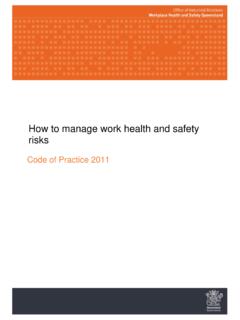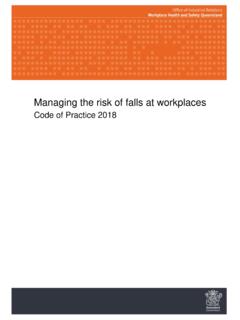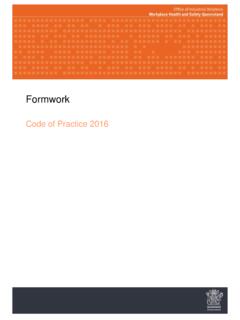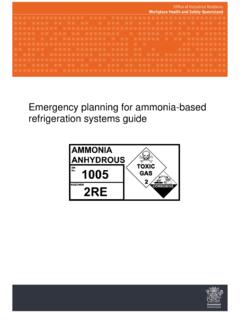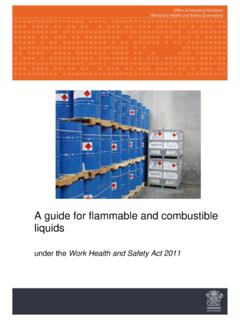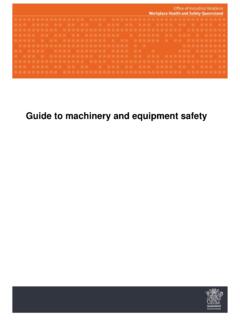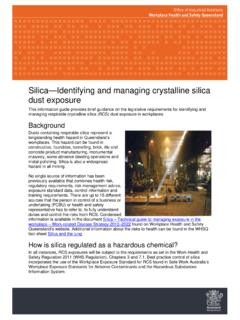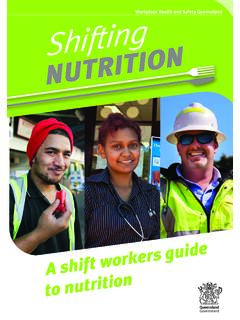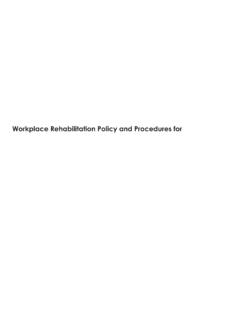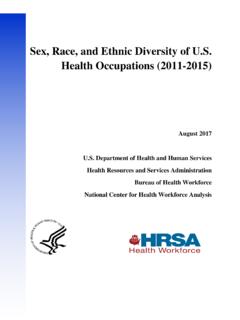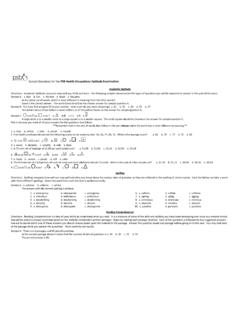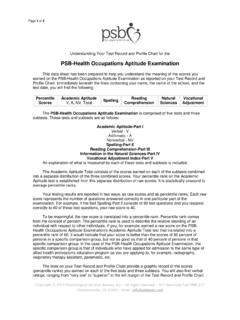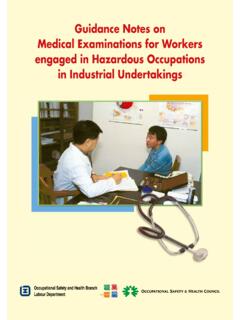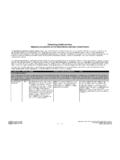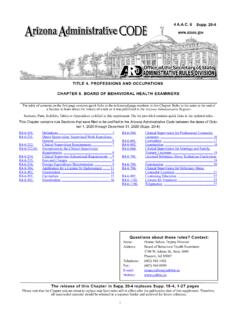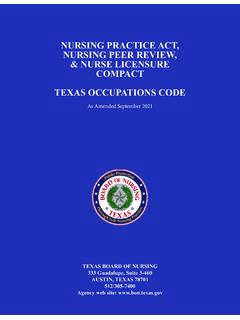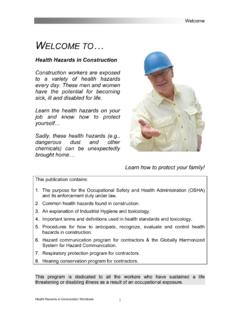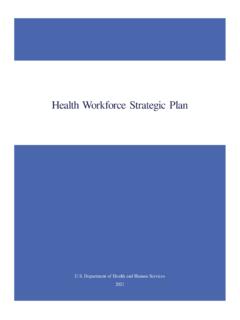Transcription of Preventing and responding to occupational violence
1 PN11651 Preventing and responding to work-related violence April 2014 1 Preventing and responding to work-related violence July 2014 Developed in consultation with the HWSA working group (ACT, Comcare, NSW, QLD, SA, VIC, WA) PN11651 Preventing and responding to work-related violence April 2014 2 Contents What is work-related violence ? .. 3 Definition .. 3 Sources of work-related violence .. 3 Preventing work-related violence .. 4 Your obligations .. 4 PCBU duties .. 4 Worker duties .. 4 Consultation .. 4 Risk management .. 5 Identifying hazards and assessing risks .. 5 Controlling the risks .. 6 Reviewing risk control measures .. 8 Case studies ( Preventing work-related violence ) .. 8 Social worker .. 8 Call centre staff .. 8 responding to work-related violence .. 9 At the time of an incident .. 9 Immediately after an incident .. 9 Incident management .. 10 Incident 10 Investigation principles .. 10 Case studies ( responding to work-related violence ) .. 11 Service station attendant.
2 11 Parking inspectors .. 12 Further information .. 13 Appendix A - Sample work-related violence prevention policy .. 12 Appendix B - Work-related violence risk management tool .. 12 PN11651 Preventing and responding to work-related violence April 2014 3 What is work-related violence ? Definition Work-related violence is any incident where a person is abused, threatened or assaulted at work. This definition covers a broad range of actions and behaviours that can create a risk to the health and safety of workers. Some industries describe behaviours that fit this definition as acting out , challenging behaviour or behaviours of concern . Examples of work-related violence include: biting, spitting, scratching, hitting and kicking throwing objects pushing, shoving, tripping and grabbing verbal threats, armed robbery and sexual assault attacking with any type of weapon (for example knives, guns and clubs). Sources of work-related violence This guide covers two types of work-related violence : 1.
3 External violence . 2. Service-related violence . External violence is usually associated with robbery or other crimes and the perpetrator is someone from outside the workplace. It can happen in any industry but often occurs in the retail, hospitality, security, cash-handling, finance and banking industries. Examples of external violence include: a sales assistant, working alone at night, threatened with a knife and robbed a construction worker hit by a bottle thrown by an aggravated motorist a receptionist experiencing domestic violence , which eventually extends to their workplace via abusive visits and phone calls. Service-related violence arises when providing services to clients, customers, patients or prisoners. It generally occurs in the hospitality, retail, health , aged care, disability, youth services, education and enforcement industries. Often, service-related violence is unintentional but it does cause harm and is therefore a risk to a worker s health and safety.
4 Examples of service-related violence include: a nurse slapped by a patient who wakes up in a confused state after surgery a teacher pushed over while intervening in a schoolyard brawl. PN11651 Preventing and responding to work-related violence April 2014 4 Preventing work-related violence Work-related violence is most common in industries where people work with the public or external clients. It often causes physical or psychological injury, and sometimes can be fatal. It can also impose costs to industry and the community through increased workers compensation and insurance premiums. occupations affected by work-related violence include: doctors, nurses, ambulance officers, welfare workers, personal carers, hotel receptionists, waiters and housekeeping staff police officers, prison guards, sheriffs, teachers, probation officers and debt collectors front-office staff, call centre staff, cashiers and security guards bus drivers, taxi drivers, couriers, pilots and cabin crew sales people, those who work alone or in remote locations and shift workers.
5 Your obligations Work health and safety laws are designed to ensure the health and safety of workers and others in the workplace. health includes physical and psychological health . PCBU duties A person who conducts a business or undertaking (PCBU) has a primary duty of care to ensure the health and safety of their workers and others in the workplace. They must provide and maintain, so far as is reasonably practicable, a safe and healthy working environment and they must consult with their workers (and with other PCBUs when applicable) about health and safety issues. Worker duties A worker must take reasonable care of their own health and safety in the workplace, and the health and safety of others who may be affected by their actions. They must also cooperate with reasonable instructions given by the PCBU. Consultation Consulting with workers and other PCBUs about work-related violence should occur when: identifying risks in the workplace making decisions about ways to prevent and manage work-related violence risks making decisions about information and training on work-related violence witnessing signs that work-related violence is affecting the health and safety of workers proposing changes that may affect the health and safety of workers.
6 PN11651 Preventing and responding to work-related violence April 2014 5 Detailed information about consultation is available in the Work health and safety consultation, co -operation and co -ordination Code of Practice 2011 at Risk management Managing the risks of work-related violence is a planned, systematic process. It involves: identifying hazards and assessing risks to determine: o what could harm workers o how likely it is that harm could occur, for example not very likely , very likely o how serious the harm could be, for example minor, serious or fatal. controlling risks, which focuses on determining the most effective risk control measures for any given circumstance reviewing and improving the effectiveness of control measures, to ensure prevention measures are working as planned and, when necessary, improved. Consulting with workers, health and safety representatives (HSRs) and health and safety committees (HSCs) is required at each step of the risk management process.
7 Drawing on the experience, knowledge and ideas of workers is more likely to result in the identification of all hazards and the selection of effective control measures. For more information on the risk management process, see the How to manage work heath and safety risks Code of Practice 2011 at Identifying hazards and assessing risks Work-related violence hazards generally arise as a result of: the work environment the work tasks and how they are carried out the way work is designed and managed. Typical hazards that give rise to work-related violence include: handling cash, drugs or valuables working alone, working in isolation, working in the community and working at night providing services to distressed, angry or incarcerated people enforcement activities. Sometimes, a worker may be deterred from reporting a violent incident because: it is thought to be part of the job and nothing can be done about it the worker believes that only serious incidents are to be reported there is a perception that nothing will happen if the incident is reported the worker believes they will be blamed for the incident the reporting process is time-consuming and complex they just want to forget about it.
8 PN11651 Preventing and responding to work-related violence April 2014 6 To determine if violence is a potential hazard in the workplace: talk with HSRs, HSCs, workers, customers and clients walk through and inspect the workplace review workers compensation claims refer to industry standards and guidelines examine local crime statistics. review the hazard and incident reports To determine the likelihood that someone will be harmed by work-related violence , ask yourself: has it happened before, either in this workplace or somewhere else? if it has happened, how often does it happen? To determine the possible consequences, ask yourself: will it cause minor or serious injury, or death? Controlling the risks There are many ways to control the risk of work-related violence , however some measures are more effective than others. Risk control measures should be selected on the basis of highest protection and most reliability.
9 The most effective control measures eliminate the hazard and associated risk, for example eliminating cash handling in a public car park by introducing an electronic payment system. If it is not reasonably practicable to eliminate the hazard, the risk should be minimised by implementing a range of control measures, for example, in a bank, use engineering controls, such as anti-jump barriers, CCTV and other security measures, as well as administrative controls, such as cash-handling procedures. Administrative controls are designed to minimise exposure to a hazard they rely on human behaviour, are open to error and are the least effective way of minimising risks. Control measures must eliminate or minimise the risk and must not introduce a new hazard. Physical work environment and security The physical work environment can affect the likelihood of violent incidents and the ease in which people can respond. Multiple control measures should be used and the following are the most reliable and provide the highest protection for workers: Ensure the building is secure, maintained and fit for purpose.
10 Use security measures such as CCTV, anti-jump screens and timer safes. Separate workers from the public where possible, for example with protective barriers or screens. Control access to the premises and vulnerable areas. Prevent public access to the premises when people work alone or at night. PN11651 Preventing and responding to work-related violence April 2014 7 Ensure workers can see who is coming into the premises and can restrict access if necessary. Fit communication and alarm systems and ensure they are regularly maintained and tested. Limit the amount of cash, valuables and drugs held on the premises. Store cash, valuables and drugs securely. Develop and implement cash-handling procedures , for example, electronic funds transfer only, locked drop safes, carry small amounts of cash, vary banking times and display limited cash held signs. Use safe glass, for example laminated, toughened or substitute glass for an alternative product like Perspex (in picture frames and mirrors also).
